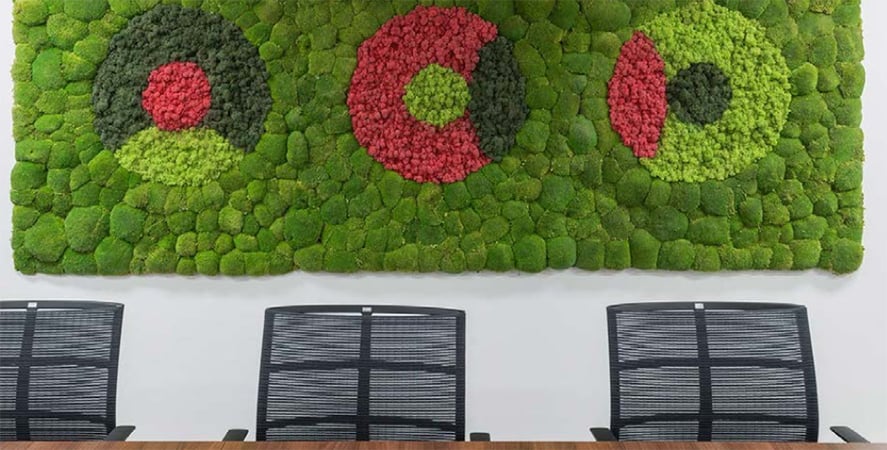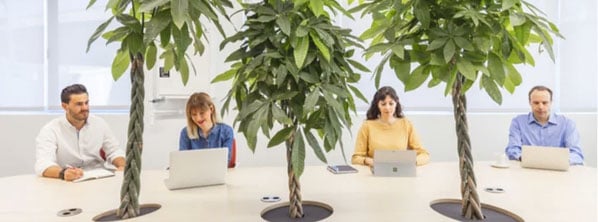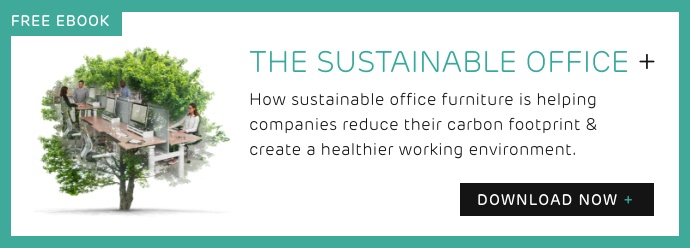Biophilic design can bring the calming, inspirational and rejeuvenating power of the outdoors, indoors. It should be embraced as a major part of a worker wellbeing strategy
Many studies have shown that exposure to elements of the natural world — such as fresh air, lush greenery and natural lighting — can energize us, increase our productivity and improve our wellbeing.
Research
shows that employees who work in environments that incorporate natural elements in their design report a 15% higher level of wellbeing, are 6% more productive and are 15% more creative overall
So, how can the introduction of natural materials and design motifs into our working environments help inspire, galvanise and protect us as we build a better, Post-Covid workplace?
1. Biophillic installations can bring wellbeing rewards
Big statement biophilic design features like ‘living walls’ can be dramatic centre pieces for a reinvented post-Pandemic office.
Following Covid, offices are now evolving into hubs for interaction and innovation, ‘destinations’ for inspiring collaborative work and meetings, places where we ‘choose to go’ rather than where we necessarily ‘have to go’.
In this ‘hybrid world’ the office has attained a new status and role, a place where we go to connect with others, to affirm our sense of belonging and shared purpose. With this in mind, there’s never been a more important time to focus on office design as the embodiment of these shared values, a place where organic connection can happen and where creativity thrives.
Setting up a living wall or vertical garden within your office, as a central feature of your ‘third space’ (the shared areas where teams socialise, break out and congregate for group activities) can send exactly this message to your workers. It might embody a commitment to a greener corporate approach, or a shared sense of nurturing and growth.

And in addition to the potential aesthetic power and symbolic qualities of the green wall, there are other tangible benefits this approach can bring your teams.
Sagegreenlife have recorded impressive and quantifiable improvements in worker wellbeing where green walls have been cultivated:
- 60% improvement in air quality of internal spaces, through the reduction of air spores and airborne bacteria
- 30% increase in creative productivity
- 60% fewer sick days reported
Not only this but the acoustic benefits of green walls in busy spaces is noticeable (absorbing 95% of sound in a room), thus increasing levels of concentration and calm.
Greenwalls are scalable solutions - they can be right sized to your available space - while still retaining their impact, making them potentially a more manageable solution than installing a ‘statement staircase’ or other architectural feature to bring new energy to your workspace.
2. Biophilia can bring a softer approach to post-Covid design
Biophilia as a design element is playing its part in delivering offices that support healthier, more ‘Covid’ sensitive workplaces, too.
Plants can be used to offer more organic and natural control around navigation, noise control, as well as encouraging spacing between individuals and teams.

As we have discussed in this blog before, planting can be used to divide large space - to control noise and make areas more intimate for small team work and one-to-one sessions, while still letting air flow naturally.
Biophilic boundaries can be effective natural reminders and cues for distancing. They can be more subtle and effective than signage and less ugly and disruptive than other kinds of 'barriers'.
3. Materiality makes the difference
But away from the literal interpretation of biophilic design companies are also discovering new ways to bring the benefits of biophilia to their workers
It seems there are many ways the shapes, textures, rhythms and patterns of the outdoors can be incorporated into the soft furnishing, colours, materiality, lighting and other choices that we make as we design our offices.
“It’s about tricking our brains to feel like we’re in a natural environment by triggering underlying patterns that we’re programmed to recognize and feel good in.”
JOHN HAMILTON, Design Director, Coalesse
Just by the choice of the colours and textiles we use we can evoke natural shapes and figures that bring inbuilt memories of the natural world to us:
Fabrics from the collaboration between Coalesse-Designtex, have patterns which abstractly evoke the irregular rippling of water, sand or wood grain. They engage and calm the senses without being consciously recognisable as natural.

Inspired by fractals - the never ending patterns that repeat themselves in nature - in the meanders of rivers, on seashells, tree bark and skyscapes - this design approach can be a major inspiration for those wanting to bring a more natural design vocabulary to their office decor.
4. Engaging all the senses
Nature, of course, isn’t just green and it isn’t experienced one dimensionally. There are the yellow, reds and greys of sand and rocks. There are the deep earthy browns of the soil and the bark of trees. There are the sounds of water and the rustle of leaves moving in the forest.
One of the main objectives of the biophilic movement is the attempt to use this changing sensory pallette to create different kinds of spaces to settle or inspire the mind.
“Nature is full of beautiful organic shapes, such as hexagons, spirals, spikes and spheres. Rounded forms like domes, arches and vaults provide psychological comfort.”
Some spaces might seek to capture the majesty of a forest with statement pillars of rough hewn wood and light filtered through foliage. At the same time, other parts of the building might evoke a riverine feeling by installing water features and reflecting light on their surfaces to distribute its softening quality around a space.
“Whether your preferred environment is the desert, forest or ocean, nuanced design can encourage recognizable connections to nature.”
John Hamilton

5. A 'natural' navigation
The challenge of the natural world, the way new vistas are always opening up as you move through space, can also be evoked in the design and layout of your office . And they don't need to necessarily reference the natural world at all, to acheive this
In the workplace, 'wayfinding' through stimulating and changing environments can evoke the rhythms of moving through outside spaces
Using techniques such as screening, can help you continually 'reveal' new views to people as they journey through your office. This may, in turn, help you encourage workers to take the 'healthier option' as the move around the office
Encouraging movement with an element such as an “irresistible staircase” can reward those who forgo an elevator with a spatial experience and active design–exercise.
Biophilic design can be a three dimensional approach that encompasses colour, materiality, layout, texture and the use of living plants to foster a sense of wellbeing in your workforce. The evidence for its mood changing and environment enhancing capabilties is striking. The only limit for its execution is your imagination.












